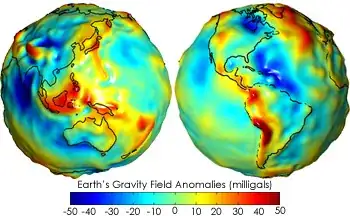As a first order approximation the Earth can be considered a sphere, if you'd like a little bit more accurate approximation you can represent it an ellipsoid of revolution (meaning two of the three axis have equal length and it rotates about the third, unequal axis). Treating the Earth as an ellipsoid -- and therefore it's gravity field as an ellipsoid -- makes the math a lot more tractable and the differences between this ellipsoidal gravity field and the actual gravity field are actually so small that they can be treated as linear. This treatment leaves you with a "normal" gravity field and a "disturbing" gravity field and makes determining it through observations a lot more simple.
The current most commonly used reference ellipsoid is WGS 84 and is completely described by four parameters:
| Parameter and Value |
Description |
| $a = 6,378,137 \: m$ |
semi-major axis of the ellipsoid |
| $f = 1/298.257223563$ |
ellipsoidal flattening |
| $GM = 3,986,004.418 $x$ 10^{8}m^{3}s^{-2}$ |
geocentric gravitational constant of the Earth (including atmosphere) |
| $\omega = 7,292,115$x$10^{-11}rad\:s^{-1} $ |
Earth's angular velocity |
These parameters are constrained through fitting the ellipsoid to empirical observation. In the satellite era where we have global data coverage from direct observations made by missions like GRACE, GOCE, etc., along with decades of terrestrial measurements, and satellite altimetry, these parameters are considered known. Note, this is for the reference ellipsoid not Earth. The value for Earth's acceleration of gravity $g \approx 9.8\: m\:s^{2}$ you referenced (and that is commonly referenced) is the average acceleration of normal gravity, or $g_{n} = 9.806\: m\:s^{2}$. This is a value that is referenced to the ellipsoid and is the theoretical value at 45 degrees latitude on the reference ellipsoid. This accuracy is sufficient for many applications.
So, in short, $g_{n}$ is known and has no uncertainty but $g_{n} \neq g_{actual}$ on Earth's actual surface. Typically $g_{actual}$ has many sources of uncertainty.
Another interesting thing to note is that we know $GM$ very well, but not so much $G$ or $M$.
